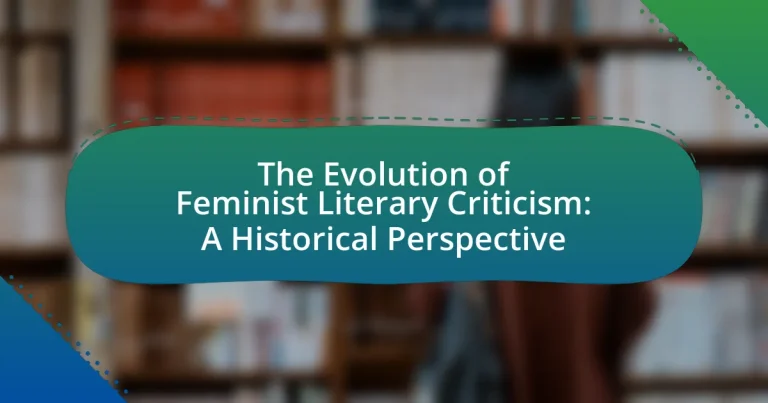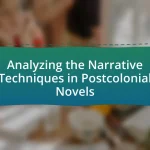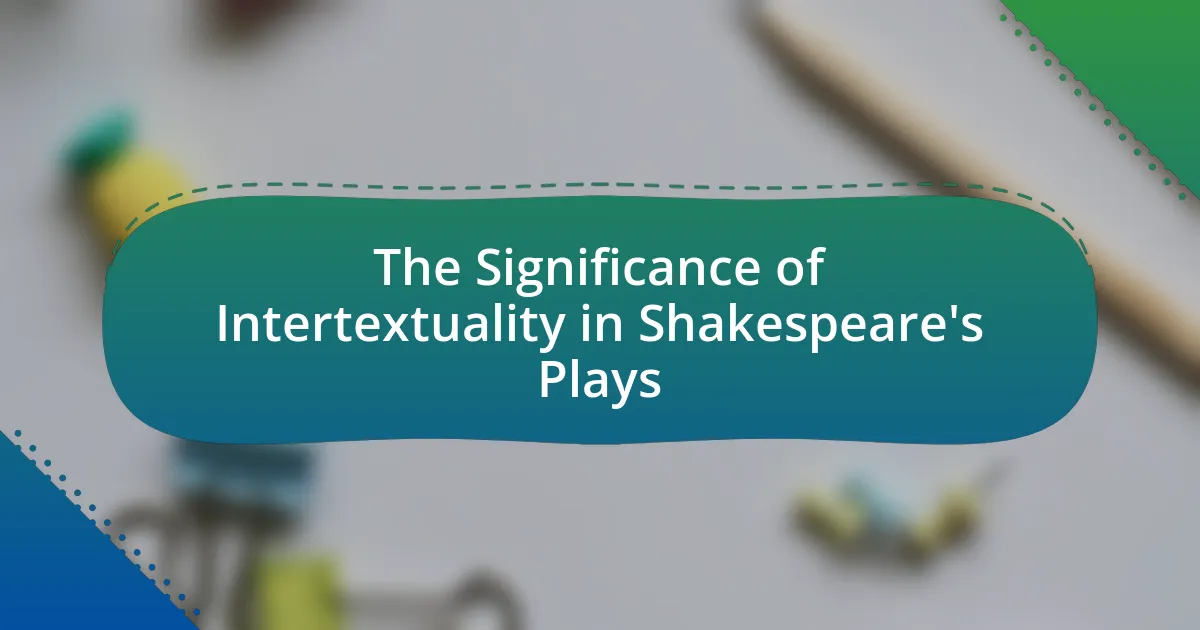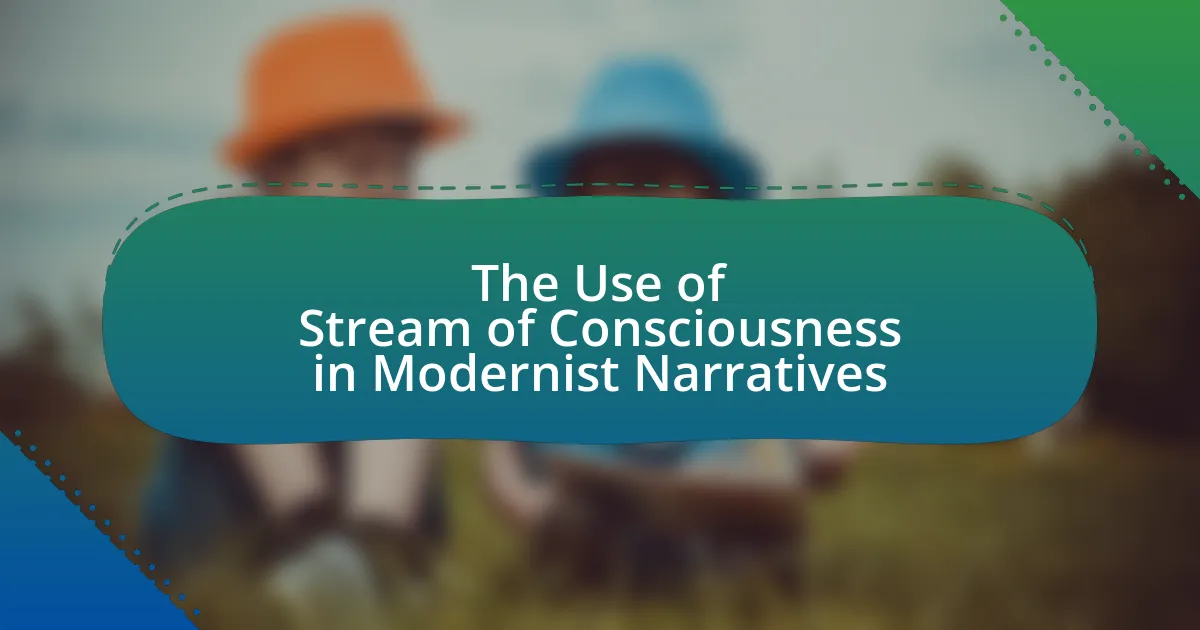The article examines the evolution of feminist literary criticism, tracing its development from the late 1960s to the present. It highlights key phases, including the initial focus on women’s representation in literature, the incorporation of intersectionality in the 1980s and 1990s, and the integration of post-structuralist theories in the 21st century. The article also discusses the historical contexts that influenced this evolution, foundational theories, and the impact of feminist literary criticism on literature and culture. Additionally, it addresses current trends, challenges, and practical approaches within the field, providing a comprehensive overview of feminist literary criticism’s significance and ongoing relevance.

What is the Evolution of Feminist Literary Criticism?
The evolution of feminist literary criticism began in the late 1960s and has progressed through several distinct phases. Initially, feminist criticism focused on the representation of women in literature, analyzing texts to uncover patriarchal biases and the marginalization of female voices. Key figures such as Elaine Showalter and Sandra Gilbert emerged during this period, emphasizing the need to critique male-dominated literary traditions.
In the 1980s and 1990s, feminist literary criticism expanded to include intersectionality, recognizing how race, class, and sexuality intersect with gender. Scholars like bell hooks and Chandra Talpade Mohanty contributed to this broader understanding, advocating for a more inclusive approach that considers diverse female experiences.
By the early 21st century, feminist literary criticism began to incorporate post-structuralist theories, questioning the very foundations of gender and identity. This shift allowed for a more fluid understanding of gender, as seen in the works of theorists like Judith Butler, who argued that gender is performative rather than fixed.
Overall, the evolution of feminist literary criticism reflects a dynamic interplay between literary analysis and social movements, adapting to changing cultural contexts while striving to amplify women’s voices in literature.
How has feminist literary criticism developed over time?
Feminist literary criticism has developed significantly since its emergence in the late 19th and early 20th centuries, evolving through various phases that reflect broader social changes. Initially, it focused on the representation of women in literature and the exclusion of female voices, as seen in the works of early critics like Virginia Woolf and Simone de Beauvoir. In the 1970s, the movement gained momentum with the rise of second-wave feminism, leading to a more structured analysis of gender roles and power dynamics in texts, exemplified by scholars such as Elaine Showalter and Sandra Gilbert. The 1980s and 1990s introduced intersectionality, emphasizing how race, class, and sexuality intersect with gender, as articulated by critics like bell hooks and Audre Lorde. Today, feminist literary criticism continues to adapt, incorporating postcolonial and queer theories, reflecting an ongoing commitment to examining how literature shapes and is shaped by societal norms regarding gender. This evolution demonstrates a shift from merely critiquing texts to understanding the complex interplay between literature and cultural contexts.
What historical contexts influenced the emergence of feminist literary criticism?
The emergence of feminist literary criticism was influenced by several historical contexts, primarily the women’s suffrage movement, the rise of second-wave feminism in the 1960s and 1970s, and the broader cultural shifts towards gender equality. The women’s suffrage movement, which gained momentum in the late 19th and early 20th centuries, highlighted the need for women’s voices in literature and society, prompting scholars to examine how literature reflected and shaped gender roles. Second-wave feminism, characterized by activism for reproductive rights, workplace equality, and sexual liberation, further propelled feminist critiques of literature, as theorists like Elaine Showalter and Sandra Gilbert began to analyze texts through a feminist lens. Additionally, the cultural shifts of the 1960s and 1970s, including the civil rights movement and countercultural movements, created an environment ripe for questioning traditional narratives and advocating for marginalized perspectives, thereby establishing a foundation for feminist literary criticism.
What key movements and milestones mark the evolution of feminist literary criticism?
Key movements and milestones that mark the evolution of feminist literary criticism include the emergence of the first-wave feminist movement in the late 19th and early 20th centuries, which focused on women’s suffrage and education, leading to early critiques of male-dominated literary canon. The second wave in the 1960s and 1970s expanded this critique, emphasizing the representation of women in literature and the exploration of gender roles, exemplified by works like “The Madwoman in the Attic” by Sandra Gilbert and Susan Gubar. The third wave, beginning in the 1990s, introduced intersectionality, acknowledging the diverse experiences of women based on race, class, and sexuality, as seen in the writings of bell hooks and Judith Butler. Each of these movements contributed to a broader understanding of gender in literature, shaping feminist literary criticism into a multifaceted field.
What are the foundational theories of feminist literary criticism?
The foundational theories of feminist literary criticism include liberal feminism, radical feminism, psychoanalytic feminism, and socialist feminism. Liberal feminism focuses on gender equality and advocates for women’s rights within existing social structures, emphasizing the need for equal access to education and employment. Radical feminism critiques the patriarchal structures that oppress women, arguing for a complete societal overhaul to eliminate male dominance. Psychoanalytic feminism draws on Freudian theories to explore the impact of gender on identity and the unconscious, examining how literature reflects and shapes women’s experiences. Socialist feminism combines Marxist and feminist theories, analyzing how capitalism and patriarchy intersect to perpetuate women’s oppression. These theories have evolved through historical contexts, influencing literary analysis and interpretation.
How do different feminist theories approach literary texts?
Different feminist theories approach literary texts by analyzing gender roles, power dynamics, and representation of women within literature. Liberal feminism focuses on equality and advocates for women’s rights, often examining how texts reflect or challenge societal norms. Radical feminism critiques patriarchy and explores how literature perpetuates male dominance, emphasizing the need for women’s voices. Marxist feminism analyzes the intersection of capitalism and gender, highlighting how economic factors influence women’s representation in texts. Ecofeminism connects environmental issues with feminist concerns, examining how literature reflects the exploitation of both women and nature. Each theory provides a distinct lens, contributing to a comprehensive understanding of gender in literature.
What role do intersectionality and diversity play in feminist literary criticism?
Intersectionality and diversity are crucial in feminist literary criticism as they provide a framework for understanding how various social identities, such as race, class, gender, and sexuality, intersect to shape individual experiences and perspectives. This approach allows critics to analyze texts not only through a singular lens of gender but also to consider how overlapping identities influence characters and narratives. For instance, Kimberlé Crenshaw’s concept of intersectionality highlights that women of color face unique challenges that differ from those experienced by white women, thus enriching the analysis of literature by incorporating multiple viewpoints. By embracing diversity, feminist literary criticism can challenge dominant narratives and promote a more inclusive understanding of literature that reflects the complexities of real-world experiences.
What impact has feminist literary criticism had on literature and culture?
Feminist literary criticism has significantly reshaped literature and culture by challenging traditional narratives and highlighting women’s voices and experiences. This critical approach has led to the reevaluation of canonical texts, revealing gender biases and promoting the inclusion of female authors and perspectives. For instance, the work of feminist critics like Elaine Showalter and Sandra Gilbert has brought attention to the ways in which literature reflects and perpetuates patriarchal values, thereby influencing both academic discourse and popular culture. Additionally, feminist literary criticism has fostered the emergence of new genres and forms, such as women’s literature, which explores themes of identity, agency, and resistance. This impact is evident in the increased visibility of female authors in literary awards and the broader cultural conversation surrounding gender equality.
How has feminist literary criticism reshaped the interpretation of canonical texts?
Feminist literary criticism has reshaped the interpretation of canonical texts by highlighting the gender biases and power dynamics embedded within literature. This critical approach has revealed how traditional interpretations often marginalize female voices and experiences, leading to a reevaluation of texts that were previously considered neutral or universal. For instance, feminist critics like Elaine Showalter and Sandra Gilbert have analyzed works such as “Jane Eyre” and “Moby-Dick,” exposing the patriarchal structures that influence character development and narrative perspective. Their analyses demonstrate that understanding these texts through a feminist lens not only enriches the reading experience but also challenges the dominance of male-centric interpretations, thereby transforming the literary canon itself.
What contributions have feminist critics made to contemporary literature?
Feminist critics have significantly influenced contemporary literature by challenging traditional narratives and advocating for the representation of women’s voices. They have deconstructed patriarchal structures within texts, revealing how gender biases shape literary themes and character development. For instance, feminist literary criticism has led to the reevaluation of classic works, highlighting the roles of female characters and the implications of their portrayals. This critical lens has also fostered the emergence of new literary forms and genres that prioritize women’s experiences, such as feminist science fiction and women’s autobiographies. Furthermore, feminist critics have contributed to the canon by promoting works by women authors, thereby expanding the scope of literature to include diverse perspectives. This shift has been evidenced by the increased visibility of female writers in literary awards and academic curricula, reflecting a broader cultural recognition of women’s contributions to literature.
How does feminist literary criticism relate to other literary theories?
Feminist literary criticism intersects with other literary theories by challenging traditional narratives and highlighting the role of gender in literature. This approach critiques patriarchal structures found in texts, similar to postcolonial criticism, which examines the impact of colonialism on literature and culture. Both feminist and postcolonial theories emphasize the importance of marginalized voices, advocating for a broader understanding of identity and power dynamics. Additionally, feminist literary criticism often engages with psychoanalytic theory, exploring how gender influences psychological development and character representation. This relationship underscores the complexity of identity, as seen in works that analyze female characters through both feminist and psychoanalytic lenses. Thus, feminist literary criticism not only stands alone but also enriches and is enriched by its connections to other literary theories, fostering a more nuanced understanding of literature.
What are the similarities and differences between feminist literary criticism and Marxist criticism?
Feminist literary criticism and Marxist criticism both analyze literature through the lens of social structures, but they focus on different aspects of oppression. Feminist literary criticism emphasizes the representation of women and gender dynamics in literature, seeking to uncover how texts perpetuate or challenge patriarchal norms. In contrast, Marxist criticism examines class struggle and economic power dynamics, analyzing how literature reflects and critiques capitalist ideologies.
Both approaches share a commitment to social justice and critique of dominant ideologies, but they diverge in their primary focus: feminist criticism centers on gender, while Marxist criticism centers on class. For example, feminist critics may analyze a novel’s portrayal of female characters to highlight gender inequality, whereas Marxist critics might explore how the socioeconomic status of characters influences their actions and relationships. This distinction illustrates how each framework provides unique insights into the complexities of power and identity in literature.
How does feminist literary criticism intersect with postcolonial and queer theories?
Feminist literary criticism intersects with postcolonial and queer theories by examining how gender, race, and sexuality shape literary texts and cultural narratives. This intersection highlights the ways in which colonial histories and heteronormative structures influence women’s experiences and identities in literature. For instance, postcolonial feminist critics analyze how colonialism has impacted women’s roles and representations in both colonized and colonizer societies, while queer theory challenges the binary understanding of gender and sexuality, offering a more nuanced view of identity. Scholars like Chandra Talpade Mohanty and Judith Butler have contributed to this discourse, emphasizing the importance of intersectionality in understanding the complexities of oppression and resistance in literature.
What are the current trends and future directions in feminist literary criticism?
Current trends in feminist literary criticism include intersectionality, which examines how various social identities such as race, class, and sexuality intersect with gender, and the focus on global feminism that addresses diverse cultural contexts. Future directions are likely to emphasize digital feminism, exploring how technology influences gender representation in literature, and the incorporation of ecofeminism, which connects environmental issues with feminist theory. These trends reflect a broader understanding of gender dynamics and aim to include marginalized voices, as evidenced by the increasing number of feminist texts that challenge traditional narratives and highlight diverse experiences.
How are digital humanities influencing feminist literary criticism today?
Digital humanities are significantly influencing feminist literary criticism today by providing new tools and methodologies for analysis and interpretation. These digital tools enable feminist critics to analyze large datasets of texts, uncover patterns, and explore intersections of gender with other social categories such as race and class. For instance, projects like the Women Writers Project have digitized and made accessible a vast array of women’s writings, allowing for comprehensive textual analysis that was previously unfeasible. Additionally, the use of digital mapping and visualization techniques helps feminist scholars to visualize the geographical and historical contexts of women’s literature, thereby enriching the understanding of its impact and relevance. This integration of technology into feminist literary criticism not only broadens the scope of analysis but also democratizes access to literary texts, fostering a more inclusive discourse.
What challenges does feminist literary criticism face in the modern literary landscape?
Feminist literary criticism faces several challenges in the modern literary landscape, including the fragmentation of feminist theory and the rise of intersectionality. The diversification of feminist perspectives has led to debates over which voices and experiences should be prioritized, complicating the establishment of a unified feminist critique. Additionally, the increasing emphasis on intersectionality highlights the need to consider race, class, sexuality, and other identities alongside gender, which can dilute the focus of traditional feminist literary analysis. Furthermore, the commercialization of literature and the dominance of mainstream narratives often marginalize feminist voices, making it difficult for feminist criticism to gain traction in popular discourse. These challenges reflect the evolving nature of feminist thought and the necessity for feminist literary criticism to adapt to contemporary social dynamics.
What practical approaches can be taken in feminist literary criticism?
Practical approaches in feminist literary criticism include analyzing texts through the lens of gender dynamics, exploring the representation of female characters, and examining the socio-political context of the works. These methods allow critics to uncover underlying patriarchal structures and highlight the voices of marginalized women. For instance, scholars like Elaine Showalter have emphasized the importance of “gynocriticism,” which focuses on women’s writing and experiences, thereby validating women’s perspectives in literature. Additionally, intersectionality, a concept introduced by Kimberlé Crenshaw, can be applied to understand how race, class, and sexuality intersect with gender in literary texts. This multifaceted approach enriches the analysis and fosters a deeper understanding of the complexities within feminist literature.
How can readers apply feminist literary criticism to their own reading practices?
Readers can apply feminist literary criticism to their own reading practices by actively analyzing texts for gender representation, power dynamics, and the portrayal of female characters. This approach encourages readers to question traditional narratives and consider how societal norms influence literature. For instance, examining the roles and agency of women in classic works, such as those by Jane Austen or Charlotte Brontë, reveals underlying patriarchal structures. Additionally, readers can explore contemporary texts through a feminist lens, identifying themes of empowerment or oppression, which enhances their understanding of both the literature and the cultural context in which it was produced. This method aligns with feminist literary criticism’s goal of uncovering biases and advocating for diverse voices in literature.
What resources are available for those interested in exploring feminist literary criticism further?
Key resources for exploring feminist literary criticism include foundational texts such as “The Madwoman in the Attic” by Sandra Gilbert and Susan Gubar, which analyzes female authors and their works through a feminist lens. Additionally, “Gender Trouble” by Judith Butler challenges traditional notions of gender and identity, providing critical insights relevant to feminist literary analysis. Academic journals like “Signs: Journal of Women in Culture and Society” and “Feminist Studies” publish contemporary research and discussions in the field. Online platforms such as Project MUSE and JSTOR offer access to a wide range of scholarly articles and books on feminist literary criticism, facilitating further exploration of the topic.




